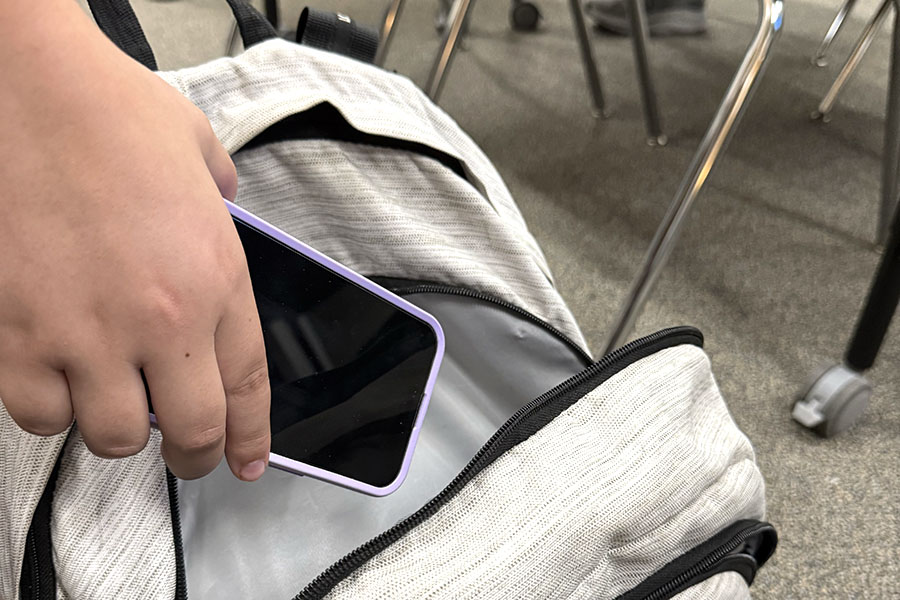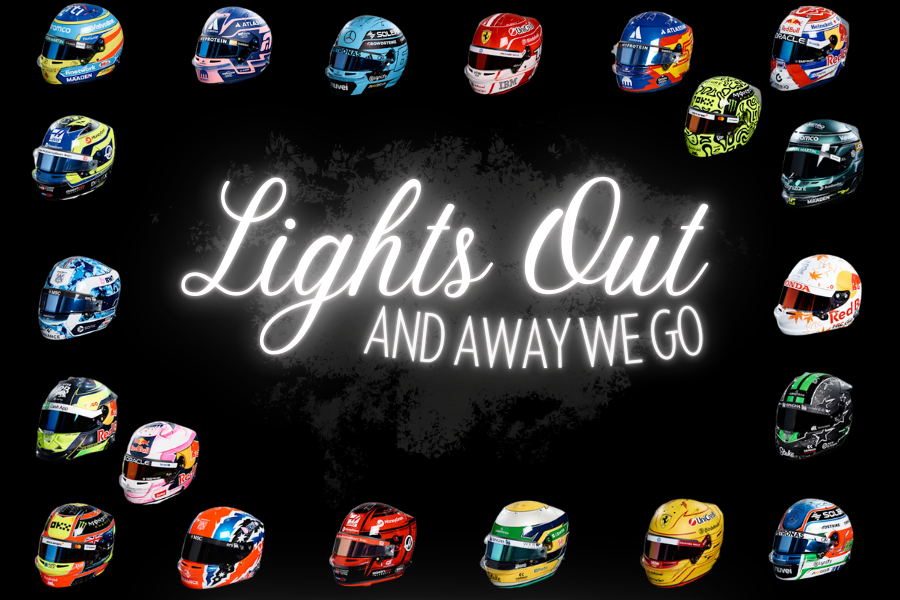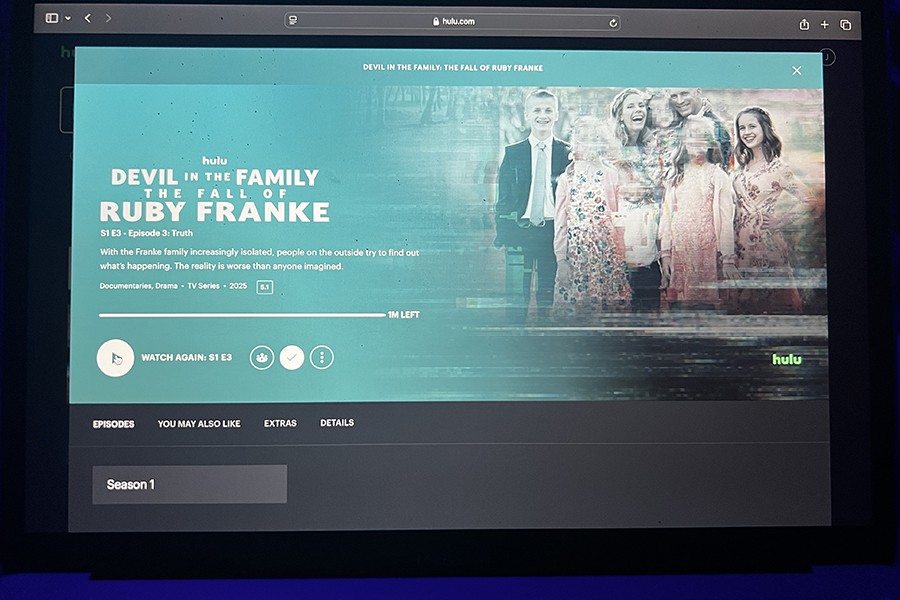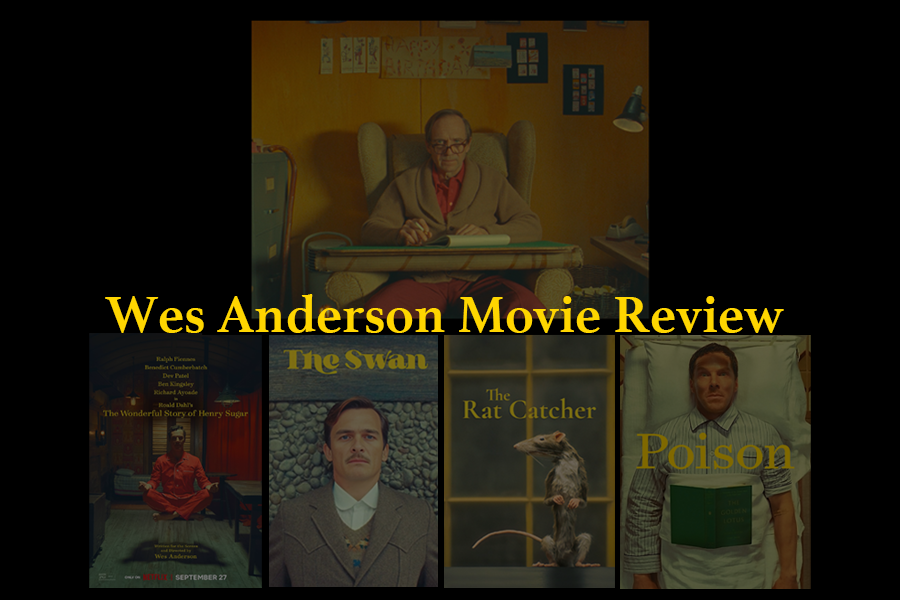For the second time this year, filmmaker Wes Anderson has released a project. Partnering with Netflix, he released four movie adaptations of the beloved stories, “The Wonderful Story of Henry Sugar,” “The Swan,” “Poison” and “The Rat Catcher” written by Roald Dahl. “The Wonderful Story of Henry Sugar” is the longest film, at around 40 minutes, but the rest do not exceed 17 minutes. Each film had a small cast, rotating the same six actors, with some playing multiple characters in one short. A slightly more unique spin, if you can even get more unique than Anderson as his natural self, is that each of these shorts were filmed almost as though it were a theater performance with moving sets, props (or lack thereof) and people, without characters handling the set and props. These stories were hilarious and entertaining, while also being very artistically charming, leaving me wanting more yet perfectly satisfied.
Born in 1916 and passed away in 1990, Roald Dahl is a British writer who was famous for his children’s books. Some of his popular works include “Charlie and the Chocolate Factory,” “Matilda,” “James and the Giant Peach” and many others. Having sold over 300 million copies of his stories worldwide, movie adaptations are often made from his stories.
The first film to be released was “The Wonderful Story of Henry Sugar,” which just so happens to be my favorite one out of all of them. Preceding this adaptation, Anderson also directed “The Fantastic Mr. Fox” in 2009. In an interview with the New York Times, Anderson talks about how he’s been wanting to make this adaptation for a while, but never knew how to do so properly saying, “The way he tells the story is part of what I like about it.” The plot is told through a story inside of a story inside of a story: being read to the audience by Roald Dahl (played by Ralph Fiennes) and the plot following Henry Sugar (played by Benedict Cumberbatch), an extremely wealthy man, who finds a book that teaches him to see through objects. As with all of his films, the set was particularly striking. Without the distinct difference in lighting and setting of the scenery, following the storylines would have proved to be particularly difficult. Not only is it technically impressive, but the story itself is captivating. The growth in Sugar’s character is remarkable, from starting as an impossibly rich, ignorant and arrogant gambler to being a selfless person with no desire for material riches.
Released the day after the first short was “The Swan.” This one was unlike most of Anderson’s films, being more dull in color, and was a very sad, yet beautiful portrayal of the indomitable human spirit. The story follows a bright young boy who is getting bullied by two boys armed with a gun. The bullies are out shooting birds, while the boy is there bird watching, already symbolizing the vast difference between the boys. He knows that there is nothing he can do against them, but eventually he realizes that he is above his bullies in every way. The theatrical approach to the directing is especially notable in this short. The narrator speaks as the child acts out what the narrator says, with a prop occasionally being passed to him. Although I was a bit thrown off by the darker themes, I truly think the artistry in the story telling and overall message was incredibly touching, making this one my second favorite.
The third film was “The Rat Catcher.” This one was my least favorite, but I still commend it for a multitude of reasons. A garage owner has a rat problem, so he hires a rat expert to eradicate them. The owner and his employee watch the Rat Man and his methods, mesmerized yet also extremely uncomfortable. Most notably, there was a scene where a rat was shown through stop motion, calling back to his “Fantastic Mr. Fox” adaptation, as well as Anderson’s exceptionally recognizable style. Additionally, I favored the acting. There were only three actors, with Ralph Fiennes playing both Roald Dahl and the Rat Man. Some might find the small cast limiting, but I found that it pushed those actors to a different level, making a hilarious and exciting result. Artistically and technically it is really well done, but it’s lacking in the whimsiness and attitude I associate with Anderson’s work.
The final out of this short film series was “Poison.” The storyline is about a man that has a venomous snake on his stomach who is discovered by another who calls the doctor. The scene builds a lot of tension and questions, but the delivery of the lines and the story provides a blanket of humor over the otherwise stressful situation. It ends with Roald Dahl finishing his reading, smoking a cigarette, and then the screen goes black. This ending keeps the integrity of the storytelling with all of the other stories but really ties in the personalities of the writers outside of the story as well.
As the result of a child raised on reading Roald Dahl and a current lover of Wes Anderson, suffice to say I was especially excited when I heard of the arrival of this series. What has always drawn me to Anderson’s movies was the almost child-like look to them and the articulate yet simple language. Paired with another eccentric writer, the result was basically a wonderfully chaotic series of plays. I very highly recommend watching each one of these, as there’s that bright creativity in each of them, and some are more mellow than others leaving options for most to enjoy.
5/5



![Jumping off the ground, senior linebacker Bennett Patton snatches the ball out of the air for an interception at Thursday’s game against Chaparral. Patton had two interceptions in the 56-14 victory, tying the school record for interceptions in a game. “I was just playing the game,” Patton said. “[I’m] going to go into next week, forget about it and stay humble.” Photo by Harper Chapman](https://cphswolfpack.com/wp-content/uploads/2025/09/bennett-interception.jpg)
![The fire department came to the school after students were evacuated when smoke started coming from the ceiling of a classroom. All students and staff are safe. “All of my friends left their stuff too, so we couldn’t contact our parents, and it was stressful,” senior Brynn Fowler said. “It was scary because I didn’t know [what was going on], and I couldn’t find anyone because it was a big crowd.” Photo by Anthony Garcia](https://cphswolfpack.com/wp-content/uploads/2025/09/firetruck.jpg)


![Sitting with her friend senior Sohpia Struve at last year’s Austin City Limits Festival, senior Ava Zuniga poses for a picture under a pavilion. They are frequent attendees at ACL, an annual music festival at Zilker Park. “I would recommend seeing a bunch of people,” Zuniga said. “This past year, we camped out for Chappell [Roan] for a really long time. I think the whole point of ACL, [which] is a lot of fun, is that you can go see so many different people, even if you don’t know them. So by camping by one person, it really limits yourself from being able to go see a bunch of people.” Photo courtesy of Ava Zuniga](https://cphswolfpack.com/wp-content/uploads/2025/10/EE9E9484-FE6F-4AA0-B5F5-0C177AB32841-1200x857.jpeg)
![Broadcast, yearbook and newspaper combined for 66 Interscholastic League Press Conference awards this year. Yearbook won 43, newspaper won 14 and broadcast took home nine. “I think [the ILPC awards] are a great way to give the kids some acknowledgement for all of their hard work,” newspaper and yearbook adviser Paige Hert said. “They typically spend the year covering everyone else’s big moments, so it’s really cool for them to be celebrated so many times and in so many different ways.”](https://cphswolfpack.com/wp-content/uploads/2025/05/edited-ILPC.jpg)




![Looking down at his racket, junior Hasun Nguyen hits the green tennis ball. Hasun has played tennis since he was 9 years old, and he is on the varsity team. "I feel like it’s not really appreciated in America as much, but [tennis] is a really competitive and mentally challenging sport,” Nguyen said. “I’m really level-headed and can keep my cool during a match, and that helps me play a bit better under pressure.” Photo by Kyra Cox](https://cphswolfpack.com/wp-content/uploads/2025/09/hasun.jpg)


![Bringing her arm over her head and taking a quick breath, junior Lauren Lucas swims the final laps of the 500 freestyle at the regionals swimming competition on date. Lucas broke the school’s 18-year-old record for the 500 freestyle at regionals and again at state with a time of 4:58.63. “I’d had my eye on that 500 record since my freshman year, so I was really excited to see if I could get it at regionals or districts,” Lucas said. “ State is always a really fun experience and medaling for the first time was really great. It was a very very tight race, [so] I was a bit surprised [that I medaled]. [There were] a lot of fast girls at the meet in general, [and] it was like a dogfight back and forth, back and forth.” Photo by Kaydence Wilkinson](https://cphswolfpack.com/wp-content/uploads/2025/03/Kaydence-2.7-23-edit-2.jpg)
![As the support team sits and poses for a photo in the cafeteria with the counseling team they eagerly wait to start their day. "We [all] seem to be a team, I get up every day and there's days where I don't want to go to work today, but I'm thankful that I have a job and I'm blessed to have what I have," Christopherson said. Photo Courtesy of Julie Weltens.](https://cphswolfpack.com/wp-content/uploads/2025/01/AF9E8470-10D7-4C91-BF28-EC8F86BAB66C-1200x852.jpeg)
![Officer Stephanie Cash is in her second year as an SRO at CPHS. “Seeing [students] grow over the years has been kind of cool,” Officer Cash said. “Freshmen that [are] all over the place and then in the next couple of years get a little more squared away and go to class and do work and start thinking about the future. Being a part of a student's growth is the best way to measure my success as an SRO.” Photo Courtesy of Cedar Park Police Department's PIO, Alicia Gallagher.](https://cphswolfpack.com/wp-content/uploads/2024/12/CPHS-SRO-900x1200.jpg)
![As he sprints with the ball, senior running back Trae Hill breaks a tackle during Friday’s 35-14 loss against the Vandegrift Vipers. Hill ran for 135 yards and two touchdowns during the game. “[Scoring] was electric,” Hill said. “It always feels good to score, but the O-line did everything.”](https://cphswolfpack.com/wp-content/uploads/2025/09/IMG_0795allie.varfb_-1200x799.jpg)















